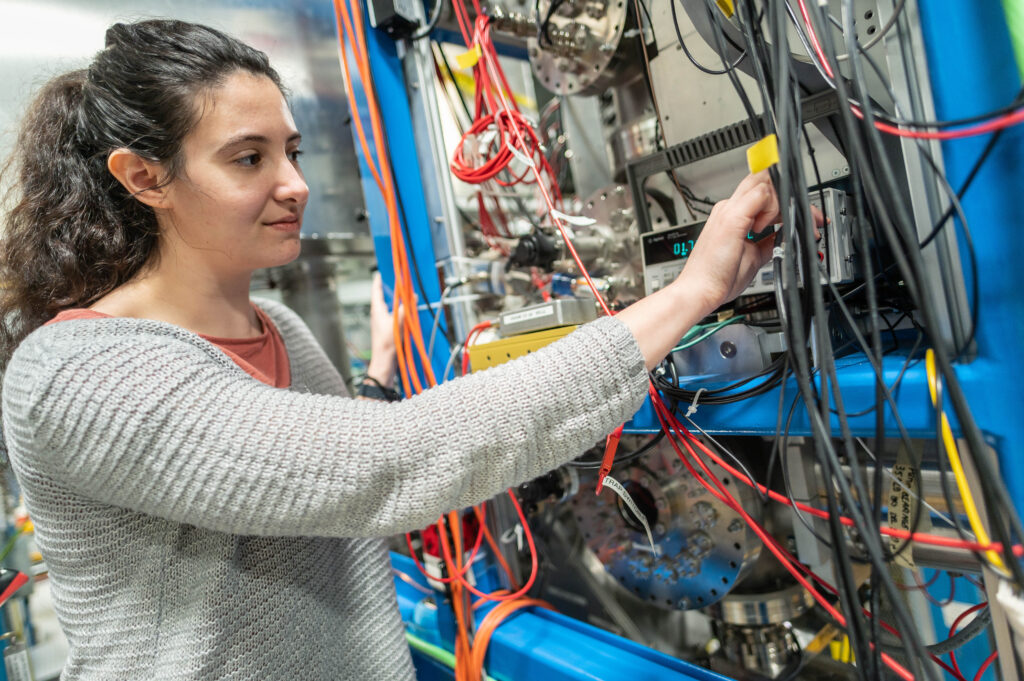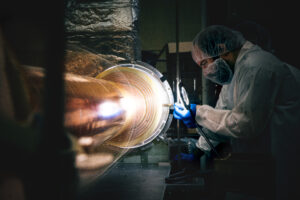Many of TRIUMF’s experiments blur the line between fundamental physics and cosmic storytelling.
A stellar example is the TITAN experiment, the TRIUMF Ion Trap for Atomic and Nuclear science, which serves as one of the world’s most sensitive mass spectrometry setups for studying the tiniest building blocks of matter. And lately, TITAN’s team has been especially prolific, penning not one, not two, but three publications in the prestigious journal Physical Review Letters since the beginning of the year. And the TITAN experiment is not just writing letters: it’s rewriting the story of how matter behaves, both in the lab and across the universe.
At its core, TITAN allows scientists to weigh the nearly unweighable: rare, short-lived isotopes that exist for mere fractions of a second. These precise mass measurements offer deep insights into the structure of atomic nuclei and, in turn, the cosmic origins of elements.
Two of these recent TITAN papers take aim at one of astrophysics’ most compelling mysteries: where do the heavy elements in the universe come from? Increasingly, evidence points to the r-process, or rapid neutron-capture process — a cosmic assembly line that builds heavy elements like gold and platinum during titanically explosive events like neutron star mergers.
In one PRL publication, led by TITAN researcher Ali Mollaebrahimi, TITAN’s team pushed the limits of detection by measuring the mass of several exotic tin isotopes, including 138Sn, never before measured in a lab. These new mass values were then fed into advanced nucleosynthesis models to refine our understanding of how the r-process proceeds in stellar cataclysms.

Researcher Ali Mollaebrahimi on the TITAN platform
Another study, a Letter eventually published on Valentine’s Day, focused on gallium and zinc isotopes (86Ga and 83Zn). Led by Andrew Jacobs, former TRIUMF Graduate Student researcher, this work similarly advanced our knowledge of the r-process, revealing how even slight shifts in nuclear mass can redirect the entire pathway of element formation in the universe.
Not all TITAN breakthroughs, however, concern the farthest reaches of the cosmos. The first PRL of 2025 brought the focus closer to nuclear structure — specifically the so-called “magic numbers” that describe particularly stable configurations of protons and neutrons. Here, former TRIUMF PhD student, Marilena Lykiardopoulou leveraged the superior precision of the TITAN mass spectrometer to reveal the intriguing possibility that quenched shell effects may reappear and even manifest in unbound nuclear systems. This work involved a collaboration with France’s CNRS and marks a first highlight of the recent International Research Laboratory founded by CNRS and TRIUMF, as highlighted in a recent CNRS communication.

Former TRIUMF PhD student Marilena Lykiardopoulou working at the TITAN facility
Behind each of these achievements is a blend of world-class experimental hardware, international collaboration, and cutting-edge nuclear theory. TRIUMF’s theorists, who are recognized as global leaders in ab-initio (first principles) nuclear modeling, also play a vital role in interpreting TITAN’s results and expanding our theoretical grasp of the atomic world.
Congratulations to team TITAN!



